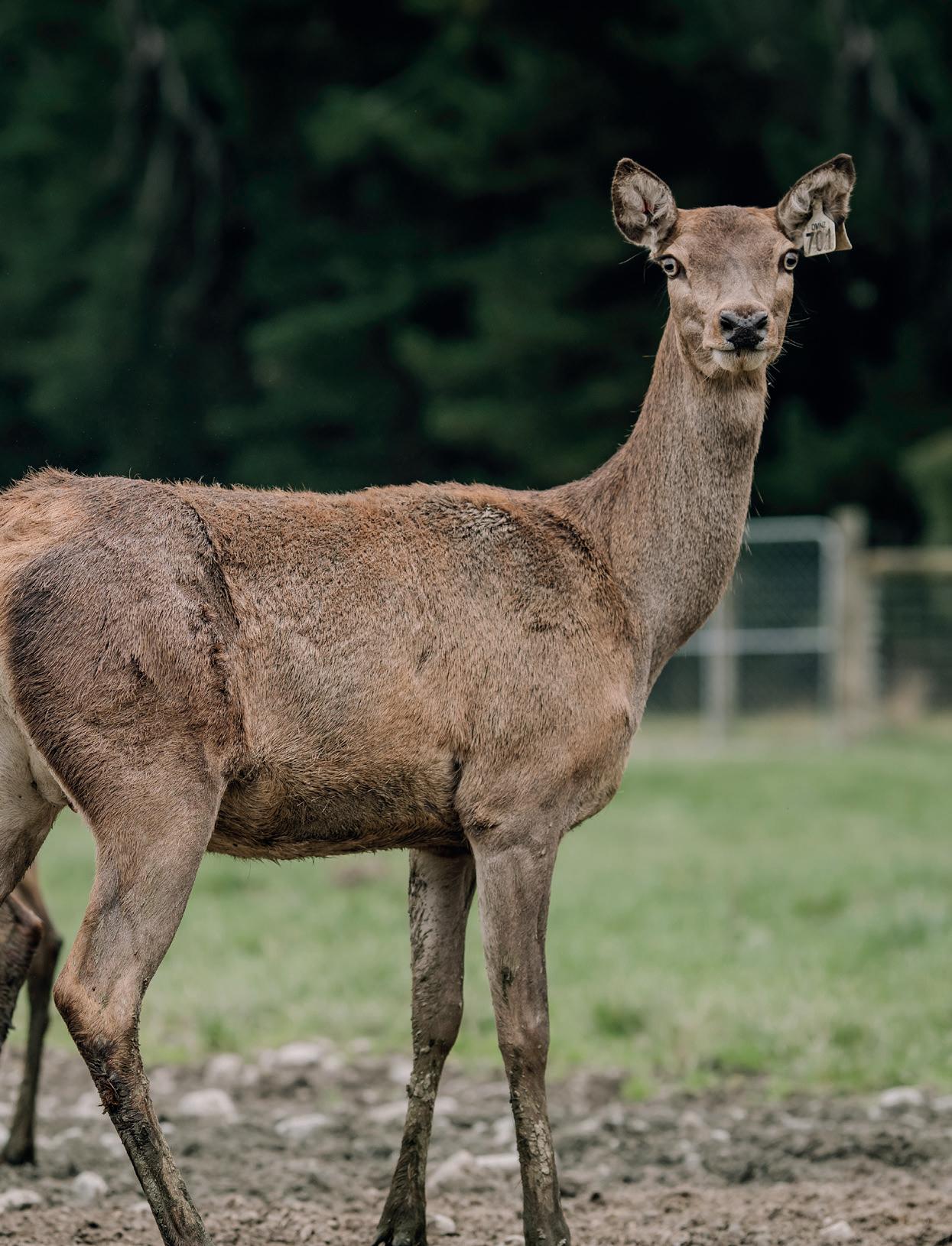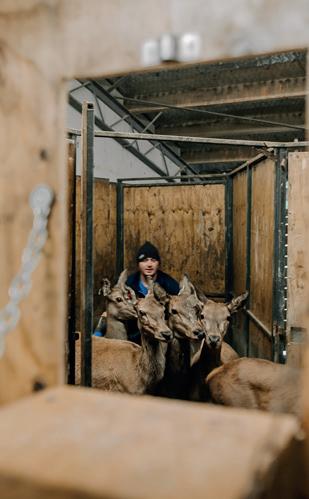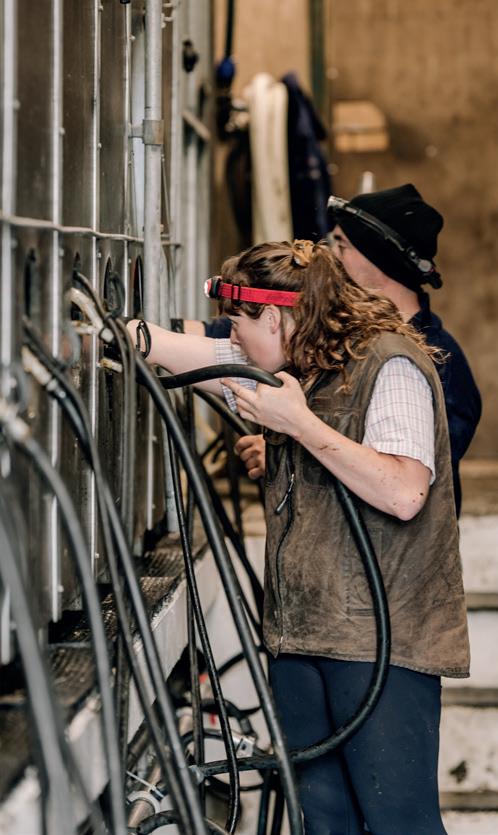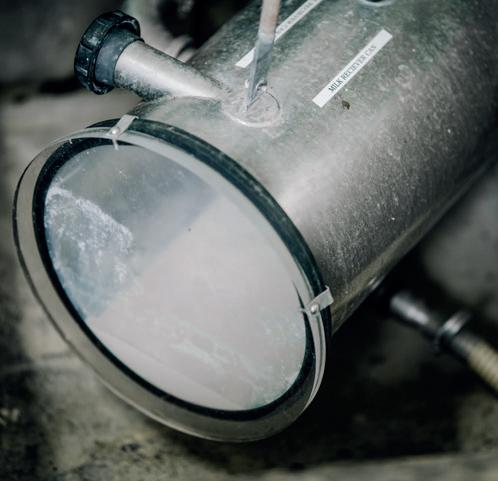
8 minute read
Outside the herd

How do cow-loving farmers find themselves milking other animals? Here are two former dairy farmers in Canterbury and the Waikato who have taken the leap and found success with other stock.
Canterbury-based deer milker Simon Wakefield is accustomed to disbelieving looks from strangers who ask about his job. The north Tipperary accent and mischievous sense of humour don’t help his case. “A lot of people think it’s an Irish joke,” the 29-year-old says of his unquestionably serious role managing a 300-head deer milking operation. His workplace forms part of Peel Forest Estate, one of the world’s largest velvet-producing deer farms. The 750ha property stands at the foot of the Southern Alps, between the Ashburton and Hinds rivers, facing the Canterbury Plains and the West Coast. It’s a far cry from the small dairy farm – 23 cows on less than 20ha – where he was raised, southwest of Dublin.



| Dairy infrastructure was repurposed for the pioneering deer milking operation. The hinds are milked twice, two teats at a time.
The Irishman arrived in New Zealand 9 years ago seeking science and agribusiness work experience, with a plan to milk cows for 6 months before returning home to finish his studies. A stint driving tractors led Simon to the deer farm and he soon found himself helping out in the shed “for a few days” during a quiet patch. That was 7 years ago. “It’s endlessly fascinating to me. I think it’s quite a cool thing to be part of and it’s definitely worth the challenge. No-one thought you could milk a deer.” In the early days, the dairy farmer’s son did find it difficult to spend up to 5 hours in the shed only to check the vat and find a mere 100 litres of milk in the bottom. “That’s versus milking 800 or 900 cows and having 20,000 litres of milk in there. It was definitely a mental struggle thinking, what are we doing this for? Surely there’s an easier way? “I wasn’t there at the very start but I was here the second year in. The deer were very skittery then, like milking a dairy heifer every day. We were trying to domesticate deer to a whole new level.” However, Simon relishes the unknown. He likes the mental and physical challenge involved and has relished being able to create systems and efficiencies that aid the fledgling industry. These days things look different in the modified 14 aside herringbone shed where each animal has to be milked twice,
two teats at a time. Milking now takes about 3 hours, as the herd is split in two. Initially, milking hinds were selected for their good temperament. Over the last 4 years, focus has increasingly turned to production volumes, which have roughly doubled to a litre per hind. Simon says this approach has had an unforeseen benefit beyond the shed. “In the deer industry, people don’t select hinds on the basis of milk production but by doing that, you end up with bigger fawns. Increasing the output of the hind is increasing the input for the fawns, which has an effect on deer farming as a whole. “The thing I’ve always liked about the dairy industry is you could see the result of your work every day in the vat. If you get it wrong, production tells you.”
This particular form of milk is naturally high in protein and milk solids and low in lactose. Of all commercially produced milk, it is the one that most closely resembles human milk. “Now that we have great hinds and they’re giving a great result in terms of milk quality, I’m starting to learn lots from the data collection around it. It’s the pioneering aspect I like, stumbling on information no-one else has seen in the deer industry in the world. “With Farmlands, I feel as though there’s genuine interest in what we’re doing. Our struggle was that if we had a problem, we couldn’t look up the solution on the internet. Or ask someone. You have to sort of try different things to see what works and doesn’t work. The great thing about our Farmlands rep is he’s happy to experiment alongside us.” Although Simon still has a soft spot for the dairy herd of his youth, the farmer admits his current venture involves “less kicking, less shit”. He finds the deer surprisingly calm in and around the shed, although certainly trickier creatures to fetch from a paddock. “They are very different from cows. Very sensitive. They sense stress, anger, hurry. If you’re in a hurry don’t even bother going near them.” Whatever animal he farms in future, the New Zealand resident has no plans to return home. “There are a lot more opportunities here if you’re willing to work and surround yourself with the right people. I can see I have an exciting future in farming here in New Zealand.”
Simon Wakefield

| Production volumes have doubled to a litre per hind.


| Sheep milkers Kate Walls and Barry Taylor with their dog, Sweep.
In the north
Satisfied sheep milker Kate Walls is accustomed to people doubting her career choices. She recalls plenty of pessimistic responses when she gave up primary school teaching to work alongside her partner, Barry Taylor. “Barry was milking cows while I was teaching but I wanted to do what he was doing,” Kate says. “I remember people saying ‘Oh, she won’t last’. People think it’s a hard life, that you work all day, no holidays. These are people from the city who haven’t ever been on a farm.” She loves the autonomy and flexibility, the ability to down tools and watch her son at a sports game or school event. There were plenty more doubters when the couple sold their cows and switched to sheep dairying. The sharemilkers had purchased their 69ha Maramarua dairy farm, in north-east Waikato, in 2016 and leased 70ha next door to milk 280 cows. But those first few years were tough. “It’s heavy clay soil that pugs in winter and is bone dry in summer. Winter was awful. I could smell palm kernel mixed with clay soil all throughout the house, the dogs were covered. You couldn’t get away from this mud. One day, I lost it. I burst into tears and said, you’re flogging a dead horse.” When a friend suggested milking sheep, she was as sceptical as anyone. “I just laughed and said, what else are you going to consider? Cats?”

| Fresh from milking, the ewes make the most of a bail of maize silage.

| Hand-reared Alice knows how to get into the shed to steal maize meant for the ewes.
It turned out the area was ideal for sheep farming, perfect for early lambing, with far less fertiliser required. And the lighter animals meant no pugging in wet weather. “We bought our first ewes in December 2018. I went and YouTubed a lot of stuff on sheep, the sheep milking process. The first sheep milk tanker arrived on 1 September, 2020.” They modified the existing shed themselves, with the help of a local engineering business, to milk up to 720 ewes, 36 aside. Only two teats on each. And they made additional adjustments to the pit to suit Kate and their other farm workers, although Barry has to hunch his 1.98m frame over the smaller animals. “We did wonder what the hell we were doing lots of the time,” Barry admits. “But it wasn’t working with dairy. We weren’t making a lot of money, we weren’t making the farm better. We were just working all the time and never really got very far ahead. For me, the excitement is seeing the potential in what the better producing ewes can do.” He still loves cows and has kept 30 ‘old favourites’ on the property, including one 17-year-old. However, he does enjoy sheep milk in his morning coffee. Milk solid percentages are higher than both goats and cows and a good ewe will produce more than 2 litres a day. The farmers find their flock easy to train – “they’ll do anything for food” – and physically much easier to move and manage than bovines. The farm itself is in better shape than it has been for years and contractors no longer drop them to the bottom of the list, unwilling to run their machines over rutted land. Kate says she has received excellent help and support from staff at their local Ngatea Farmlands store, including referral to a Farmlands animal nutritionist who offered practical solutions to a bloat issue. “They see me every day – it’s where I get our farm supplies and they’ve all been great. But what I’ve really enjoyed is that they don’t laugh at me when I go in there with unusual ideas. “The industry is still learning. The other day we met with one of the other suppliers and I think 15 new ideas just came from that. I like that collaborative aspect.” Currently, most of their milk is processed into infant milk formula for export. It fetches a premium thanks to its digestibility, low lactose content and creamy, slightly sweet taste. Greenridge Sheep Dairy staff have also experimented with cheesemaking, creating haloumi and feta for their own consumption. “And oh yes, our lifestyle has improved. We only milk 7 or 8 months of the year. We’re also going on holiday. We’re going to do the things we could never do.”










